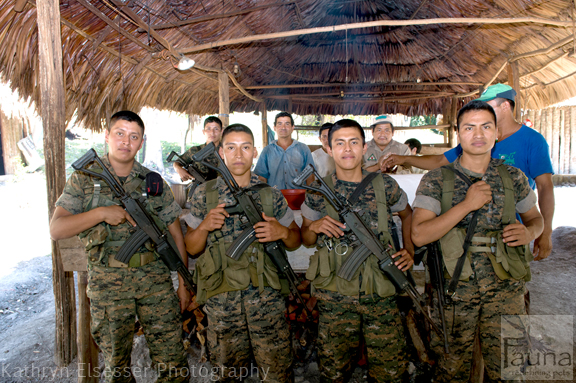Series: Part 1 | Part 2 | Part 3 | Part 4 | Part 5
As many of you know, Daniel Kopulos, owner of Fauna, will be returning to Guatemala in May 2013 to continue his conservation work with Scarlet Macaws, Mesoamerican River Turtles and Jaguars. As he embarks on this adventure, we thought it would be fun for us to relive his past excursion in Guatemala in 2012, as well as educate and answer questions we’ve received from our many supporters of this conservation project. We will present Daniel’s exciting and important story in a series of interview questions and photos. Enjoy!
Guatemala Project: Part 5
Dangers and Surprises
Did you feel safe? Were there dangers?
In the jungle there are always dangers. Just traveling out there in a truck is dangerous. There are mudslides, fallen trees and of course it is easy to get lost, as we did last year. Once in the protected area of the forest, there is the issue of the military presence. They are young boys with automatic weapons that have been out in the forest for months at a time.
Although it is relatively safe, you want to make sure you do not upset them, and you cannot leave any of your things around as they may go missing. Even with that, I would rather run across them than the drug runners passing through Guatemala to Mexico. They are dangerous and do not play around. We’ve never crossed them, but they are always near. They tend to set forest fires as a diversion so that the forestry department and military have to deal with the fire while they skirt around the other direction. We’ve had fires very close to the field station just last year.
What surprised you the most or challenged a pre-conceived idea?
The most challenging thing for me was to understand the way things work. One of the animals we work to protect is the jaguar. Farmers kill them. Others kill them because there is an unspoken bounty on their heads that equals about the same in US dollars as the cost of a Venti coffee at Starbucks. It was hard to conceive how – for so little – someone would kill such a majestic creature – that a jaguar is valued as little as the cost of a cup of coffee.
After spending some time with the people who live in the surrounding areas to the forest, you begin to understand and accept the situation. They are financially poor – not in a way an American can typically understand. That small amount of money means so much to them. As far as the farmers are concerned, the jaguars kill their cattle. One head of cattle can support a family for a very long time. Once you see all of this, it makes sense. This doesn’t mean that it is okay, but just that you can begin to understand. What you learn is that education is what is needed.
Not all of the cattle that are killed are killed by the jaguar. Most of the ones that are killed were weaker or sickly cattle to start with. When the people are taught how to distinguish a jaguar kill vs other predators, then a huge stride has been made in conservation. Providing the cattle farmer with inexpensive veterinary assistance or husbandry assistance, helps to keep his heard strong and less vulnerable to predators; another great stride in conservation. All of this takes time and manpower. As we know from our own government policy, it can take a long time for people to accept change, even if the facts are evident.
Series: Part 1 | Part 2 | Part 3 | Part 4 | Part 5
![]()
![]() To learn more about Fauna NYC, visit our website!
To learn more about Fauna NYC, visit our website!



